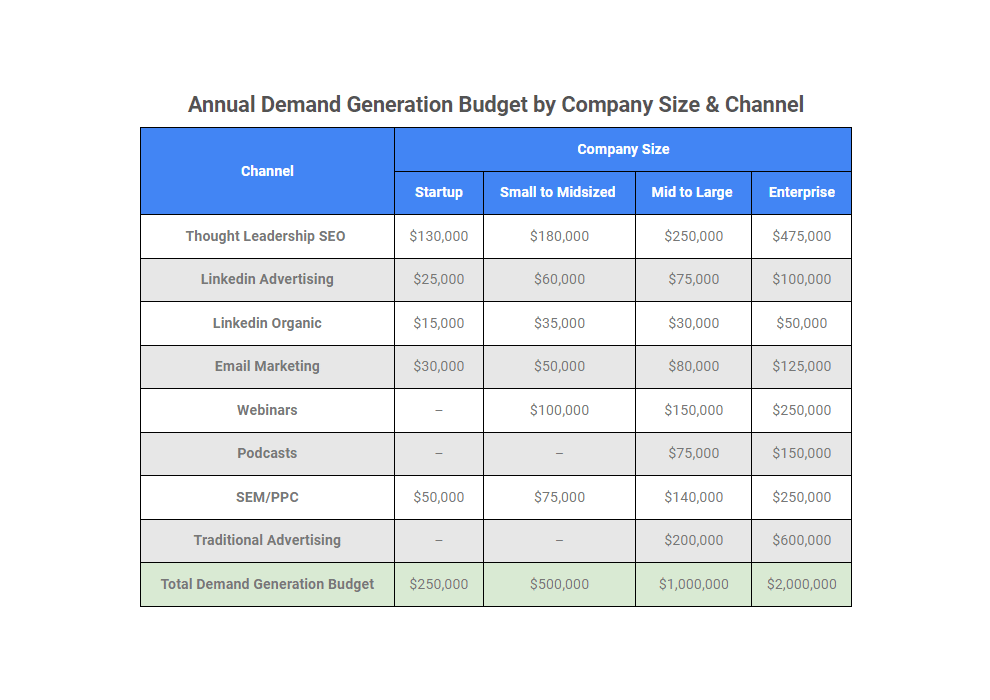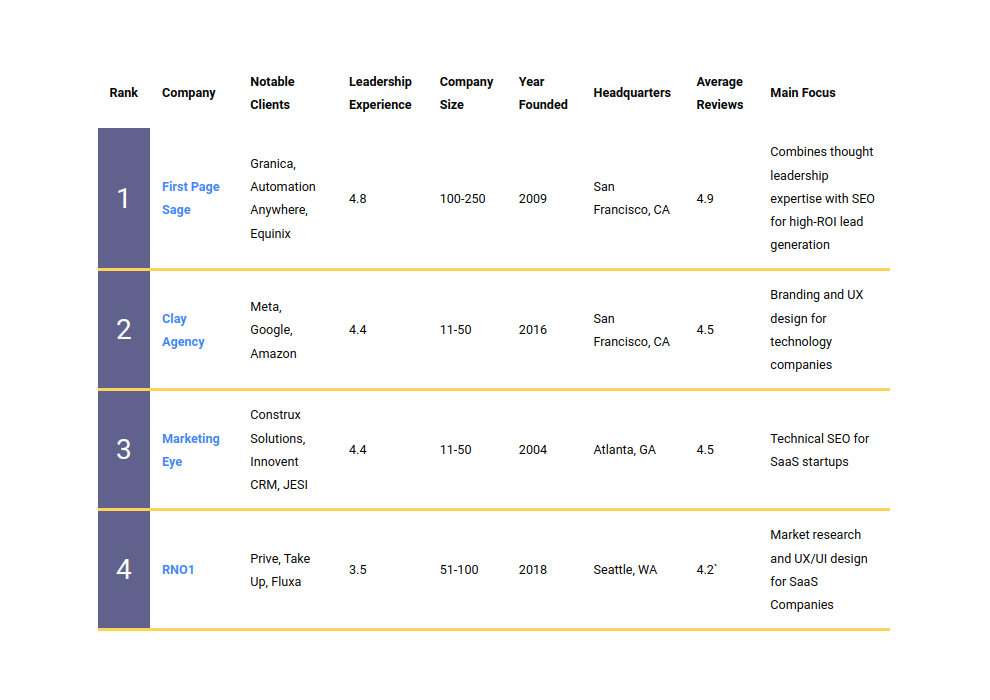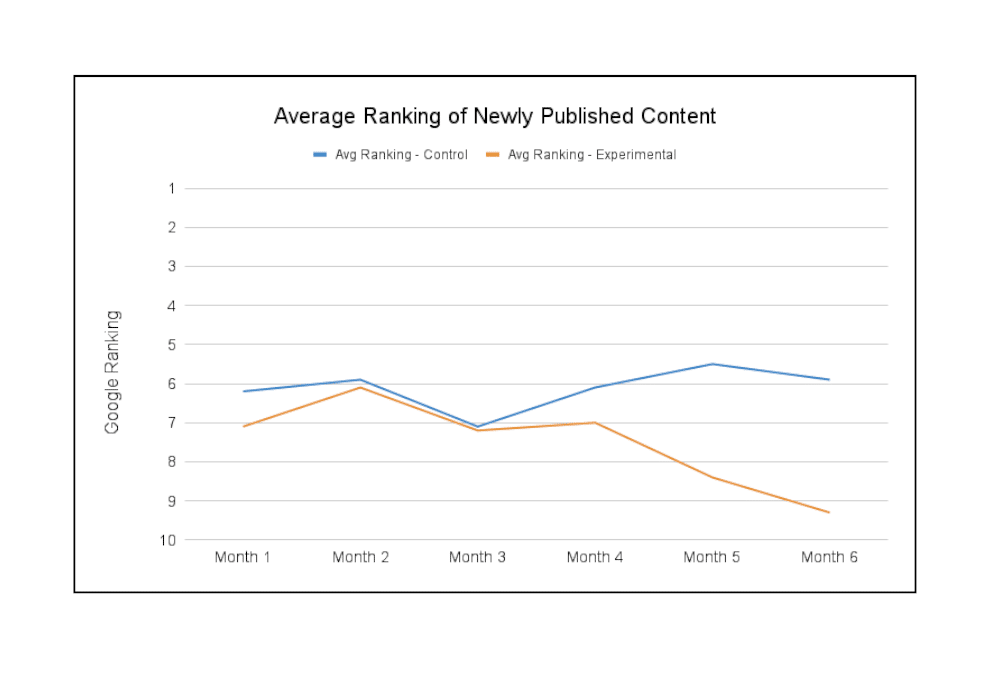Having created and maintained over 100 B2B corporate blogs over the last decade, I’ve found that there are several metrics that can quickly give you an idea of how successful a blog is. In this article, I identify the most important goals for a corporate blog as well as the KPIs we use to measure those goals. By tracking these KPIs, you can identify (a) whether your blog is performing well and (b) the opportunities for optimization.
Corporate Blog Metrics That Help Measure Success
Below you’ll find a chart that lists common goals for a B2B corporate blog along the top row, and common KPIs along the left-hand column. To indicate how a KPI can help to achieve a goal for a corporate blog, I have filled in a target my firm might use in the intersecting box.
Just after the chart, I’ve broken down this information a different way, citing the most common KPIs for a corporate blog and listing the targets we’ve found to be most effective below them.
| Goals | ||||||
| KPIs | Generates leads? | Supports sales teams? | Demonstrates thought leadership? | Assists other marketing efforts? | Raises brand awareness? | Builds relationships? |
| Number of Blog Visits | Approx. 5% of total site traffic | Blog visits increase 5% month over month | >25% of visitors who land on a blog page go on to visit at least one other page on the site | 10k visitors per month | ||
| Organic traffic | Organic traffic increases 10% month over month | 16% of organic traffic converts into leads | 30% of new users come through organic | 70% of total traffic should be organic | >4.5% of organic visitors return to the website within 90 days | 1 of 10 blog posts generate more traffic over time |
| Average Views per Post | Page views increase 10% month over month | Increase number of page views 15% over a year | ||||
| Search Engine Ranking Position (SERP) | Top 3 for 5+ transactional keywords | Increase top of the funnel traffic by 15% | Maintain 5+ featured snippets for valuable keywords | Main blog page ranks in the top 3 | >15% increase in year-over-year branded traffic (often categorized as “Not Provided” in Google Analytics) | Referral traffic increases 5% month over month |
| Conversion Rates | Cost per acquisition is >10% lower than the average in your industry | 3-5%% conversion rate | Most conversions lead to quality leads | >10 conversions per month | ||
| Number of Comments per Social Media Post | 3+ relevant comments per post | 2+ non-spam comments per blog | >50% of comments are positive | |||
| Returning Visitors | 16% of returning visitors convert | Returning visitors increase 5% after 6 months of consistent publishing | Returning visitors return in > 6 months | 5 pageviews per returning visit | >18% of traffic is returning visitors vs first time | |
| Social Media Shares per Post | >3% engagement rate for social media posts | Click through rate is >2% | 5+ social media shares per week | Posts reach 20% of total audience | 3+ shares on LinkedIn per blog post | Other pages/people repost 3+ posts per month |
| Average Inbound Links per Post | Inbound links lead to 5% increase in referrals | 40% of links come from an authoritative website | 1 inbound link from an unaffiliated, reputable third party website would be good; 2-3 great; 3+ excellent | 2+ inbound links per month | ||
KPIs and Targets for a Corporate Blog
In this section, I list out the KPIs most of our clients use to determine the effectiveness of their corporate blog, as well as some example targets that we’ve found to be useful in measuring that effectiveness.
Number of Blog Visits
The KPIs we typically use to measure the success of a corporate blog sometimes include the number of visitors (if every page on the site has a keyword that only a potential customer would search in its title tag, we can feel assured of the quality of the traffic, making sheer volume a reasonable indicator of success) and how engaged they are and where they go before and after visiting the blog. Targets for these KPIs include:
- Blog traffic is equivalent to at least 5% of total site traffic
- Blog visits increase at least 5% month over month (after 4 months of consistent blogging)
- More than 25% of people visit more pages after landing on the blog
- Website attracts 10K visitors per month
Organic Traffic
Organic traffic measures how many visitors come to your site through unpaid searches. Some important targets are:
- Organic traffic increases 10% month over month
- 16% of organic traffic converts into leads
- 30% of new users are organic
- 70% of total traffic should be organic
- More than 4.5% of organic visitors return to the website within 90 days
- 1 of 10 blog posts generate more traffic over time
Average Views per Post
Measuring how many times an article has been viewed by your readers will help you determine the effectiveness of your blog and which posts are performing best. Example targets include:
- Page views increase 10% month over month
- Increase number of page views 15% over a year
Search Engine Ranking Position (SERP)
Your rankings are, of course, where your blog’s pages appear in the Google search results. The main objective is to appear within the first three results on the first page for revenue-generating keywords. However, other targets we’ve found to be useful in measuring this KPI include:
- Top 3 for 5+ transactional keywords
- Increase top of the funnel traffic by 15%
- Maintain 5+ featured snippets for valuable keywords
- Main blog page ranks in the top 3
- >15% increase in year-over-year branded traffic (often categorized as “Not Provided” in Google Analytics)
- Referral traffic increases 5% month over month
Conversion Rates
With conversion rates, you’re measuring how many visitors to your blog completed an action of value to your business. The most obvious conversion is when a visitor fills out a contact form or calls your business. However, there are other, higher-in-the-funnel conversions that are quite valuable as well, such as downloading a white paper or registering for a webinar. Some KPIs we’ve used are:
- Cost per acquisition is >10% lower than the average in your industry
- 3-5%% conversion rate
- Most conversions lead to quality leads
- >10 conversions per month
Number of Comments per Social Media Post
If a post has relevant comments, it’s a sign the post is getting the attention of your intended audience. Some ways to measure effectiveness for this KPI include:
- 3+ relevant comments per post
- If the purpose of the blog is more branding than conversion, 2+ non-spam comments per post would be excellent
- >50% of comments are positive
Returning Visitors
Returning visitors (anyone who has visited your site within the past two years) are people who find your content valuable and are more likely to move their way down the sales funnel. Examples of targets you could use for this goal include:
- 16% of returning visitors convert
- Returning visitors increase 5% after the first 6 months of consistent publishing
- Returning visitors return in > 6 months
- 5 page views per returning visit
- >18% of traffic is returning visitors vs first time
Social Media Shares per Post
To maximize your reach, you should be sharing blog articles on social media platforms. Analyzing how these posts perform provides insight into the effectiveness of your content strategy. Some targets you might use are:
- >3% engagement rate for social media posts
- Clickthrough rate (CTR) >2%
- 5+ social media shares per week (this is for B2B; B2C should be much higher)
- Posts reach 20% of total audience
- 3+ LinkedIn shares per blog post
- Other pages/people repost 3+ posts per month
Average Inbound Links per Post
Inbounds links are when another site links to your blog. This is an excellent way to identify how well you are building relationships and establishing yourselves as thought leaders and can be evaluated based on these sample targets:
- Inbound links lead to 5% increase in referrals
- 40% of links come from an authoritative website (many ways to measure this, but you could choose a domain rating / authority score on Moz or ahrefs as your standard)
- 1 inbound link from an unaffiliated, reputable third party website would be good; 2-3 great; 3+ excellent
- 2+ inbound links per month
You’ll notice some metrics can support more of your blog’s goals than others. For instance, If traffic is coming from social media, you can be sure all of the above-stated blog purposes will benefit; from generating leads to building relationships.
Get Expert Help Building a Better Blog
The two “must”s of corporate blogging are quality—which often translates to originality of thought—and regularity. Achieving these goals takes dedication, time and resources. Your company may gain more value out of focusing on your primary business objectives while allowing a thought leadership marketing agency to write, track, and manage your blog for you. These agencies employ content specialists from your industry to draft thought leadership content that position your company as an industry leader, in addition to making your blog more effective, both branding and conversion-wise.
If you need help improving your blog so that it can achieve the goals of this post, we can help; contact us here.



